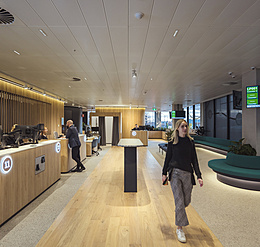Introducing Australia’s noted architect
Australia’s claim to Harry Seidler as an architectural icon is tenuous: Austrian born, Canadian educated and US influenced, his inventive modernist masterpieces are found all over the world. Yet the practice that still bears his name, and many of his most iconic buildings, are in Australia.
Seidler arrived in Australia in his 20s. His personal design style prized clarity and rationalism well-suited to the times, and he quickly earned a series of commissions, private homes distinctive for, amongst other things, their use of light. Seidler veered away from the ubiquitous centre-ceiling oyster fitting popular at the time and brought light into his designs from hidden sources; recessed into the architecture, concealed behind furniture or flooding down curtains. Conceptually, this is in line with ERCO’s “Light not luminaires” philosophy.
A proponent of Richard Kelly’s lighting ethos, when it came to Seidler’s divergence into the commercial sphere, he met with Kelly and so began an enduring lighting partnership – including, amidst his 119-project strong resume, office towers in four of Australia’s major state capital cities. Kelly was behind the New York Seagram building ‘tower of light’ created by Mies van der Rohe using Edison Price incandescent wallwashers. You can see this inspiration in many of Seidler’s early tower projects, and he continued working with Price protégé, lighting designer Claude Engle, on projects from the mid-1980s on. Engle is quoted as saying that he learned from Price to begin with what the architectural design called for and develop lighting fixtures to achieve it.








